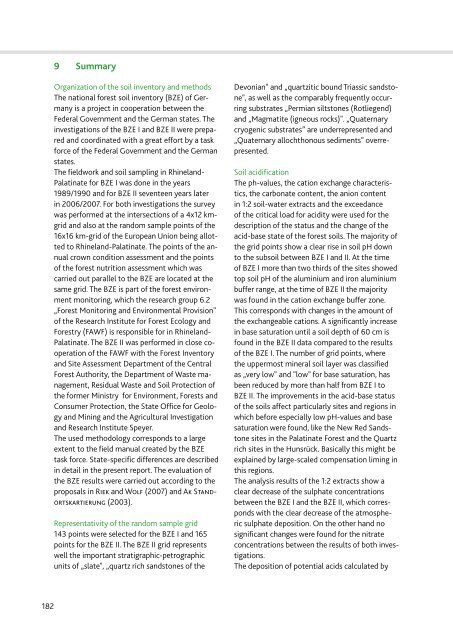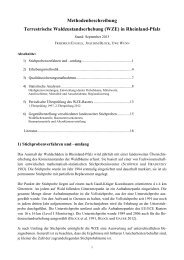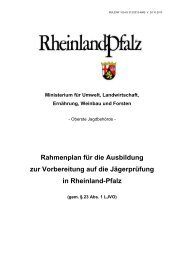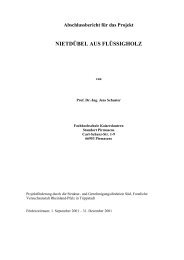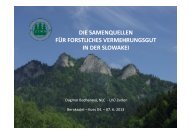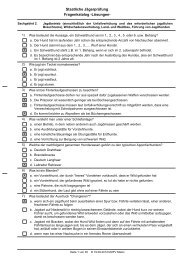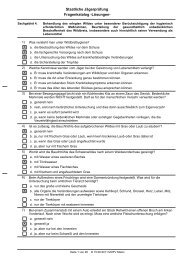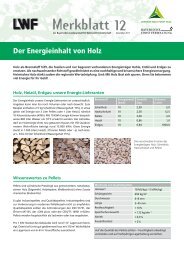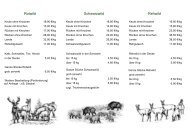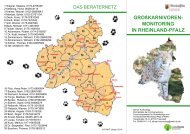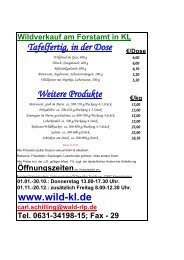Zentralstelle der Forstverwaltung - Landesforsten Rheinland-Pfalz
Zentralstelle der Forstverwaltung - Landesforsten Rheinland-Pfalz
Zentralstelle der Forstverwaltung - Landesforsten Rheinland-Pfalz
Sie wollen auch ein ePaper? Erhöhen Sie die Reichweite Ihrer Titel.
YUMPU macht aus Druck-PDFs automatisch weboptimierte ePaper, die Google liebt.
182<br />
9 Summary<br />
organization of the soil inventory and methods<br />
the national forest soil inventory (bze) of Germany<br />
is a project in cooperation between the<br />
fe<strong>der</strong>al Government and the German states. the<br />
investigations of the bze i and bze ii were prepared<br />
and coordinated with a great effort by a task<br />
force of the fe<strong>der</strong>al Government and the German<br />
states.<br />
the fieldwork and soil sampling in Rhineland-<br />
Palatinate for bze i was done in the years<br />
1989/1990 and for bze ii seventeen years later<br />
in 2006/2007. for both investigations the survey<br />
was performed at the intersections of a 4x12 kmgrid<br />
and also at the random sample points of the<br />
16x16 km-grid of the european union being allotted<br />
to Rhineland-Palatinate. the points of the annual<br />
crown condition assessment and the points<br />
of the forest nutrition assessment which was<br />
carried out parallel to the bze are located at the<br />
same grid. the bze is part of the forest environment<br />
monitoring, which the research group 6.2<br />
„forest Monitoring and environmental Provision"<br />
of the Research institute for forest ecology and<br />
forestry (faWf) is responsible for in Rhineland-<br />
Palatinate. the bze ii was performed in close cooperation<br />
of the faWf with the forest inventory<br />
and site assessment department of the Central<br />
forest authority, the department of Waste management,<br />
Residual Waste and soil Protection of<br />
the former Ministry for environment, forests and<br />
Consumer Protection, the state office for Geology<br />
and Mining and the agricultural investigation<br />
and Research institute speyer.<br />
the used methodology corresponds to a large<br />
extent to the field manual created by the bze<br />
task force. state-specific differences are described<br />
in detail in the present report. the evaluation of<br />
the bze results were carried out according to the<br />
proposals in Riek and Wolf (2007) and ak standortskartierung<br />
(2003).<br />
Representativity of the random sample grid<br />
143 points were selected for the bze i and 165<br />
points for the bze ii. the bze ii grid represents<br />
well the important stratigraphic-petrographic<br />
units of „slate", „quartz rich sandstones of the<br />
devonian" and „quartzitic bound triassic sandstone",<br />
as well as the comparably frequently occurring<br />
substrates „Permian siltstones (Rotliegend)<br />
and „Magmatite (igneous rocks)". „Quaternary<br />
cryogenic substrates” are un<strong>der</strong>represented and<br />
„Quaternary allochthonous sediments" overrepresented.<br />
soil acidification<br />
the ph-values, the cation exchange characteristics,<br />
the carbonate content, the anion content<br />
in 1:2 soil-water extracts and the exceedance<br />
of the critical load for acidity were used for the<br />
description of the status and the change of the<br />
acid-base state of the forest soils. the majority of<br />
the grid points show a clear rise in soil ph down<br />
to the subsoil between bze i and ii. at the time<br />
of bze i more than two thirds of the sites showed<br />
top soil ph of the aluminium and iron aluminium<br />
buffer range, at the time of bze ii the majority<br />
was found in the cation exchange buffer zone.<br />
this corresponds with changes in the amount of<br />
the exchangeable cations. a significantly increase<br />
in base saturation until a soil depth of 60 cm is<br />
found in the bze ii data compared to the results<br />
of the bze i. the number of grid points, where<br />
the uppermost mineral soil layer was classified<br />
as „very low" and "low" for base saturation, has<br />
been reduced by more than half from bze i to<br />
bze ii. the improvements in the acid-base status<br />
of the soils affect particularly sites and regions in<br />
which before especially low ph-values and base<br />
saturation were found, like the new Red sandstone<br />
sites in the Palatinate forest and the Quartz<br />
rich sites in the hunsrück. basically this might be<br />
explained by large-scaled compensation liming in<br />
this regions.<br />
the analysis results of the 1:2 extracts show a<br />
clear decrease of the sulphate concentrations<br />
between the bze i and the bze ii, which corresponds<br />
with the clear decrease of the atmospheric<br />
sulphate deposition. on the other hand no<br />
significant changes were found for the nitrate<br />
concentrations between the results of both investigations.<br />
the deposition of potential acids calculated by


